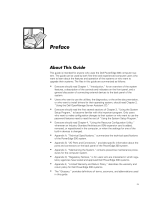Page is loading ...

xiii
!"
!701,.0
This guide is intended for users of the Dell PowerVault 200S, 201S, 210S, and 211S
storage systems (hereafter called 2xx S storage systems) who want to learn about its
features and operation and for qualified service technicians who upgrade or service
the storage system. The chapters are summarized as follows:
W Chapter 1, "Introduction," provides an overview of the storage system's features,
a description of the controls and indicators on the front panel, and information on
where to get help if you need it.
W Chapter 2, "Installing Your Rack-Mounted Storage System," describes setting up
the rack-mounted storage system.
W Chapter 3, "Installing Your Stand-Alone Storage System," describes setting up the
stand-alone storage system.
W Chapter 4, "Configuring Your ESEM or SEMM for Cluster Operation," describes
how to configure the storage system.
W Chapter 5, "Connecting Your Storage System to the Host Computer," describes
how to connect your storage system to the host computer.
W Chapter 6, "Installing Drives," describes how to install small computer system
interface (SCSI) hard-disk drives in the storage system's drive bays.
W Chapter 7, "Service Information for Technicians," discusses upgrade and service
procedures for the storage system.
W Chapter 8, "Getting Help," describes the help tools Dell provides to assist you
should you have a problem with the storage system. It also explains how and
when to call Dell for technical assistance.
W Appendix A, "Technical Specifications," provides reference material for users inter-
ested in learning more about the details of the storage system.
W Appendix B, "Maintaining Your Storage System," describes preventive mainte-
nance procedures that you should perform regularly to keep your storage system
in top operating condition.
W Appendix C, "Regulatory Notices," provides information about regulatory agen-
cies that have tested and approved the PowerVault 2xxS storage system.

xiv
!"
W Appendix D, "Limited Warranty and Return Policy," describes the warranty for the
storage system and the "Total Satisfaction" Return Policy.
W "Abbreviations and Acronyms" defines the acronyms and abbreviations used in
this guide.
Dell Computer Corporation (“Dell”) manufactures its hardware products from parts
and components that are new or equivalent to new in accordance with industry-
standard practices. For information about the Dell limited warranty for your system,
see Appendix D, Limited Warranty and Return Policy.”
In addition to this Installation and Service Guide, you may also have one or more of
the following documents:
W
User's Guide or Installation and Troubleshooting Guide for the host computer.
W Dell PowerEdge Expandable RAID Controller (PERC) 2, Dell PERC 2/DC, Dell
PERC 2/SC, or Dell PERC 3/DI documentation, which includes information on the
SCSI host adapter.
W HP OpenView Network Node Manager Special Edition (NNM SE) x.x and Dell
OpenManage Hardware Instrumentation Package (HIP) x.x documentation, which
includes information on operating the Dell OpenManage HIP server management
application program.
W Dell PowerEdge cluster installation and troubleshooting documentation.
NOTE: Documentation updates are sometimes included with your system or
software to describe changes to your system or software. Always read these
updates before consulting any other documentation because the updates often
contain the latest information.
! "
Throughout this guide, blocks of text may be accompanied by an icon and printed in
bold type or in italic type. These blocks are notes, notices, cautions, and warnings,
and they are used as follows:
NOTE: A NOTE indicates important information that helps you make better use of
your computer system.
!"
"#

xv
!"
$%&$%&!"
"#
#"#!$
The following list defines (where appropriate) and illustrates typographical conven-
tions used as visual cues for specific elements of text throughout this document:
W
Interface components are window titles, button and icon names, menu names
and selections, and other options that appear on the monitor screen or display.
They are presented in bold.
Example: Click OK.
W
Keycaps are labels that appear on the keys on a keyboard. They are enclosed in
angle brackets.
Example: <Enter>
W
Key combinations are series of keys to be pressed simultaneously (unless other-
wise indicated) to perform a single function.
Example: <Ctrl><Alt><Enter>
W
Commands presented in lowercase bold are for reference purposes only and are
not intended to be typed when referenced.
Example: “Use the format command to . . . .”
In contrast, commands presented in the Courier New font are part of an instruc-
tion and intended to be typed.
Example: “Type to format the diskette in drive A.”
W
Filenames and directory names are presented in lowercase bold.
Examples: autoexec.bat and c:\windows
W
Syntax lines consist of a command and all its possible parameters. Commands
are presented in lowercase bold; variable parameters (those for which you substi-
tute a value) are presented in lowercase italics; constant parameters are
presented in lowercase bold. The brackets indicate items that are optional.
Example: del [drive:] [path] filename [/p]
W
Command lines consist of a command and may include one or more of the com-
mand’s possible parameters. Command lines are presented in the Courier New
font.
Example:
W
Screen text
is a message or text that you are instructed to type as part of a com-
mand (referred to as a command line). Screen text is presented in the Courier
New font.
Example: The following message appears on your screen:

xvi
!"
Example: “Type and press <Enter>.”
W
Variables are placeholders for which you substitute a value. They are presented in
italics.
Example: DIMM_x (where x represents the DIMM socket designation)
/
